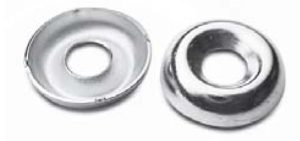
Washers are commonly used in conjunction with a threaded fastener. Bolts, for instance, are often inserted through the center of a washer. The washer will distribute the bolt’s load more evenly across the surface of the object, thus protecting the object from damage.
While most washers are flat, though, others are raised. They still have a circular shape, and they still have a hole in the center that supports a threaded fastener. Countersunk washers, though, are raised as opposed to being flat.
What Are Countersunk Washers?
Countersunk washers are washers that dip inward radially. In other words, they are raised on the sides. You can see an example of countersunk washers in the photo above. The sides of a countersunk washer are raised, but the center is relatively flat and not raised.
You can use countersunk washers by inserting a threaded fastener through the center of them. They still have a hole in the center, which is designed to accommodate a threaded fastener.
Benefits of Using Countersunk Washers
Like flat washers, countersunk washers can distribute the load of a bolt or other threaded fastener. Countersunk washers, however, are ideal for use with flat-head fasteners.
Both bolts and screws may feature a flat head. With a flat head, they’ll fit perfectly inside the canonical shape of a countersunk washer’s hole. The fastener’s head won’t protrude out. Rather, it will “sink” into the countersunk washer’s hole.
Countersunk washers are better protected against vibrations than flat washers. When installed, they’ll push against the object to resist vibrations. Countersunk washers essentially act as springs. Driving a threaded fastener through the center will force the sides of the countersunk washer to collapse, thus pushing against the object. The end result is greater protection against vibrations, which if left unchecked, could otherwise cause washers to loosen.
Things to Consider When Choosing Countersunk Washers
You can find countersunk washers available in different materials. Some of them are made of stainless steel, whereas others are made of bronze, brass, aluminum and more. When choosing countersunk washers, you should check to see what material or materials they are made of.
Don’t forget to consider then size when choosing countersunk washers. They are available in a variety of sizes. The diameter of the hole, of course, must match the diameter of the fastener with which you intend to use the countersunk washer. If it’s too big or too small, it may not support the fastener.



